| 1 | An easily recognisable watersnake |
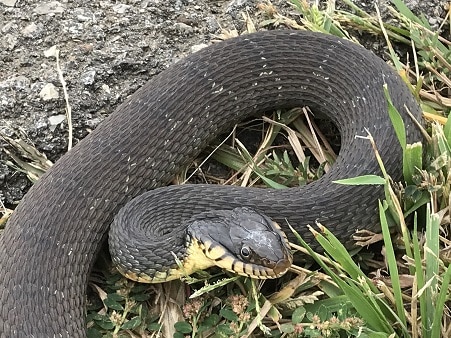
The plainbelly watersnake (Nerodia erythrogaster) is a common species of the southeastern USA, which averages at 75-120cm long, with an all-time record of 163.6cm. They’re common in eastern Texas, Alabama, etc, where they appear in marshes, swamps, small lakes and ponds. This is a non-venomous species, which lacks any constriction powers, instead grabbing its frog prey through sheer acrobatic skill, and forcing them down its throat.
The plainbelly watersnake belongs to the Nerodia watersnake genus (10 members), and overlaps with several other members in the eastern US, including northern watersnakes and brown watersnakes. They sometimes live in the exact same wetlands or burrows as each other, yet plainbelly watersnakes are easy to distinguish, thanks to one physical feature: their namesake belly.
The northern watersnake has complex patterns, with dark bands overlaid on a murky grey base. Likewise, its belly is adorned with complex dark markings. Meanwhile, a plainbelly watersnake has a single colour on its belly, with no patterns. This is often a bright pastel colour like orange, which contrasts vividly against its body.
A plainbelly watersnake’s bright underside can be recognisable from some distance, making identification simple for a layman. Their main body also has fewer patterns than a northern watersnake, as it’s typically a single solid dark brown.
| 2 | The most adventurous watersnake |
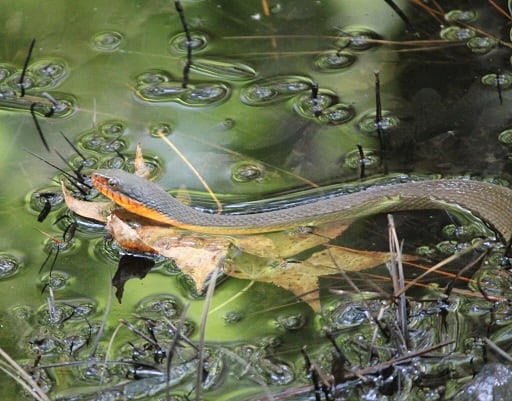
Plainbelly watersnakes tend to prefer stationary water bodies over fast-flowing. They appear in small rivers, but particularly lakes, ponds, swamps, and mixed wetlands. They appear in typical areas for a US watersnake, like riverside burrows, and on tree branches by lakes, where they drape themselves in a state of relaxation, allowing them to drop down into rivers instantly if spooked.
But there’s one big difference to their relatives: plainbelly watersnakes are the most terrestrial (land-dwelling) of the US watersnake family. They venture furthest from water, and some individuals have been found 250 metres from the nearest water source. Northern watersnakes stay very close to rivers and lakes, whereas plainbelly watersnakes will embark on expeditions through the nearby forests and fields. This brings them into people’s gardens, near agricultural areas, and onto nearby roads, where they’re sometimes killed.
Plainbelly watersnakes can be found in bogs within forests, poking their heads up and startling passers-by. They can appear in tiny local pools, and drainage ditches, only really avoiding the fastest flowing rivers.
| 3 | Migrates long distances |
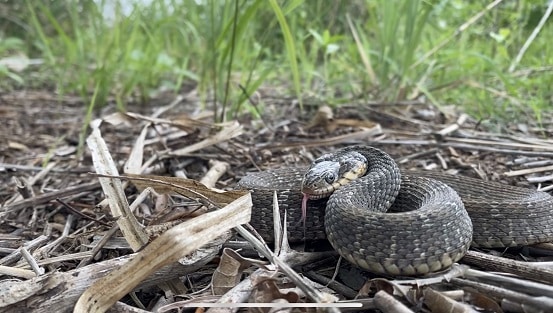
In 2003, a study analysed northern watersnakes and plainbelly watersnakes in northwest Ohio and southern Michigan, to see how their habitat preferences compared. Plainbelly watersnakes were far more restless, and continually sought out new locations. In the average season, they moved between wetlands 9.1 times. This was three times more than the northern watersnake, at a mean of 2.8 migrations. In the average migration, they moved 143.1 metres, while northern watersnakes were less adventurous at 96.8 metres. Some travelled several hundred metres away from their wetlands, to drier upland areas away from water.
One statistic was that plainbelly watersnakes were spotted in upland areas 11 times more then northern watersnakes. 30% of sightings were in upland areas for the former, and less than 3% for the latter. Plainbelly watersnakes were often found over 100 metres from their watery base, while northern watersnakes were rarely found 30 metres away.
In other words, the two species partition their habitats, each sticking to their own niche. Otherwise, they would be in heavy competition with each other, and one species would dominate the other, forcing it into extinction. Another example is the terrestrial garter snake and common garter snake, which inhabit the same fields, but the latter stays closer to streams, allowing them to coexist peacefully.
| 4 | Common in the eastern USA |
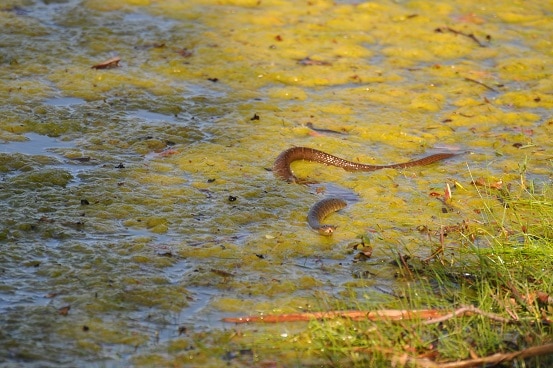
Plainbelly watersnakes are a very common snake in the eastern half of the USA. Their heartlands include Georgia, the Carolinas, Mississippi, and Louisiana, among others. They’re found in eastern Texas, and a decent way into northern Mexico, reaching the city of Monterrey. Their westernmost point lies in New Mexico, with a tiny colony in the southeast. Near Dallas and Austin, there’s so many sightings that you can barely move without jumping over them. Yet over a thousand miles away, they’re just as common near Raleigh, South Carolina.
Plainbelly watersnakes are found in Florida, but only the panhandle. Further south in peninsular Florida, the brown watersnake becomes too powerful to compete with.
The northernmost colony of plainbelly watersnakes lies in Ohio, Pennsylvania, and Michigan, which is separated from the rest of the range. Plainbelly watersnakes are far from endangered overall, but this northern enclave is in severe decline. By 1997, there were just 5 small pockets remaining. Meanwhile, northern watersnakes are thriving up north. Part of the problem is the plainbelly watersnake’s adventurous nature. While Nerodia sipedon are happy with one river or lake, plainbelly watersnakes require a buffer of up to 165 metres from the nearest large water source, to protect their ecosystems, allowing them to move around freely. Housing developments won’t swallow up whole rivers, but they might swallow up small, obscure wetlands which plainbelly watersnakes quietly depend on.
| 5 | Appears in small forest swamps |
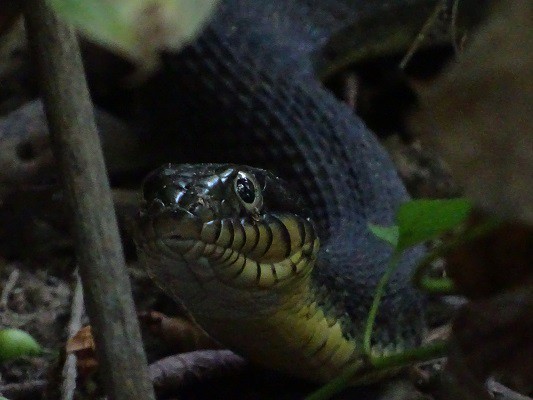
In the study, there were only 5 snakes that stuck permanently to one wetland. 4 of these were northern watersnakes, and just one a plainbelly watersnake. In smaller wetlands, plainbelly watersnakes would sometimes make only a brief stop off, lasting two or three days. They regularly appeared in obscure forest wetlands which were far too small to be discovered by satellite, or appear on any map.
Despite their differences, the two species used very similar hibernacula. In fact, a northern watersnake and plainbelly watersnake were found hibernating in the same crayfish burrow one year. Numerous species members hibernated in close proximity to each other. Crayfish burrows were particularly popular overall.
Plainbelly watersnakes will also hibernate in rock piles by streams, natural hollows, and vacant burrows of other animals. This is mainly a solitary snake, rarely gathering in writhing communal piles like the common garter snake. That said, a couple can occasionally become peas in a pod, as this heartwarming picture shows. The main time they gather is during mating season, where several males will slither towards one female. Plainbelly watersnakes are active from March to early November, disappearing during the winter.
| 6 | Diet: primarily amphibians |
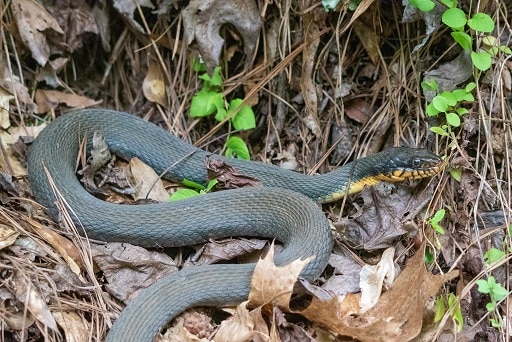
Plainbelly watersnakes are also different to their US relatives in that they mainly eat frogs and toads. Northern watersnakes eat a vast variety of fish, while brown watersnakes are pickier and eat over 60% catfish. A 1977 study from Louisiana followed 4 Nerodia members within the state. 3 species ate mostly fish: Mississippi green watersnakes, diamond watersnakes, and banded watersnakes. Plainbellies were the sole exception, eating mainly amphibians.
A more recent study from 2019 examined a location in western Kentucky. It studied 3 watersnakes found in the area, and assigned different food groups a technical score of relative importance within the diet. With plainbelly watersnakes, frogs and toads received a 78.3, and fish just 14.4. Northern watersnakes and diamond watersnakes were the reverse, scoring 87.3 and 94.5 for fish respectively.
Plainbelly watersnakes are confirmed to eat a variety of species, including squirrel treefrogs, American bullfrogs, southern toads, and gulf coast toads. Eastern newts are also confirmed, while their fish prey include green sunfish and western mosquito fish.
| 7 | Figure of 8 hunting |
One of a plainbelly watersnake’s strategies is to swim continuously at the surface of water bodies, with their mouths gaping open. They continually make turns without ever stopping, in a pattern forming figures of 8. By subtly changing direction each time, they eventually cover the whole surface of ponds. In 2006, one was observed using this figure of 8 strategy to capture a small fish.
Plainbelly watersnakes will also drag their prey onto land in an attempt to immobilise them. They’ll even anchor their coils around a rock and hold steady, to prevent a thrashing catfish from dragging them both back into the water.
Plainbelly watersnakes much prefer to swallow prey by the head, but sometimes must seize them by the tail, ripping them out of streambed crevices. If so, they’ll “walk” their jaws up the body gradually, so that they don’t release their hold, until they reach the head. This is sometimes used for elongated amphibians like lesser sirens. Plainbelly watersnakes can be so distracted while wrestling prey that they pass by humans’ feet without noticing them.
| 8 | Hard, painful bites |
Plainbelly watersnakes have a hard bite, which they’ll use without hesitation if manhandled. While non-venomous, they’re similar to northern watersnakes in that they rapidly become aggressive if provoked. Their other strategies include flattening their head for an illusion of size, and producing a vile snake odour.
Being more land-dwelling, scientists have noticed another difference to its relatives: rather than fleeing into water when spooked, they often flee to land, disappearing into undergrowth.
Another difference with Nerodia erythrogaster is larger eyes than their relatives. One study found that plainbelly watersnakes have larger heads than northern watersnakes. Their skull shape is narrower, which is theorised to be for moving through undergrowth on land, where they spend more time. Their eyes are spaced further apart than northern watersnakes, which again relates to water – aquatic snakes typically have tightly spaced eyes, to see from below water with just a small part of their head poking out.
| 9 | Preyed on by cottonmouths |
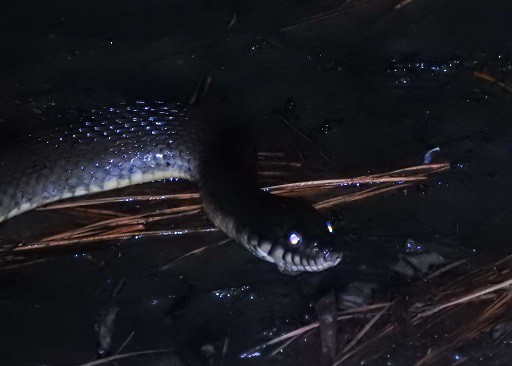
Plainbelly watersnakes are confirmed prey for fellow snakes, including cottonmouths and common kingsnakes. Their bird predators are plentiful, including red-shouldered hawks and herons. Snapping turtles will also do their thing and snap down on them. Their liking for frogs is partly why plainbelly watersnakes visit drier upland locations so often. These smaller pools are home to spawning colonies of frogs, while large rivers tend to contain more fish.
Plainbelly watersnakes may possess an advanced defensive tactic: autohaemorraging. This is deliberate bleeding, as reported by scientists in Cherokee County, Oklahoma. In March 1991, they picked up a medium plainbelly watersnake, which began to squirm and released its foul smell. When gripped behind the head, it produced droplets of blood from its mouth, similarly to the dice snake, which releases blood to convince predators of its premature demise. Plainbelly watersnakes will also make mock strikes in the direction of an aggressor.
| 10 | Lays up to 55 newborn |
Plainbelly watersnakes are a prolific breeder, though their baby factories are slightly less productive than brown watersnakes. The latter has been recorded producing 63 newborns (all Nerodia watersnakes lay live young). Plainbelly watersnakes average at 17.8 newborns, with a range of 2 to 55. These newborns measure 18-30cm, with a weight of just 3.5-10.9 grams. Mothers abandon their young instantly. At 8-15 years in captivity, plainbelly watersnakes aren’t especially long lived.
Plainbelly watersnakes were once thought to contain 5 subspecies, which included the likes of yellow bellied watersnakes from Mississippi (N. erythrogaster flavigaster), and blotched watersnakes (N. e. transversa) from Kansas. But a 2010 study found that across their vast range, there was surprisingly little genetic variation. Even with huge geographic barriers like the Mississippi river, there was little variation on either side (probably because they’re great swimmers).
Consequently, Nerodia erythrogaster is now considered to be one widespread subspecies. According to the study, there was “little support for the recognized subspecies as… independent evolutionary lineages“.
